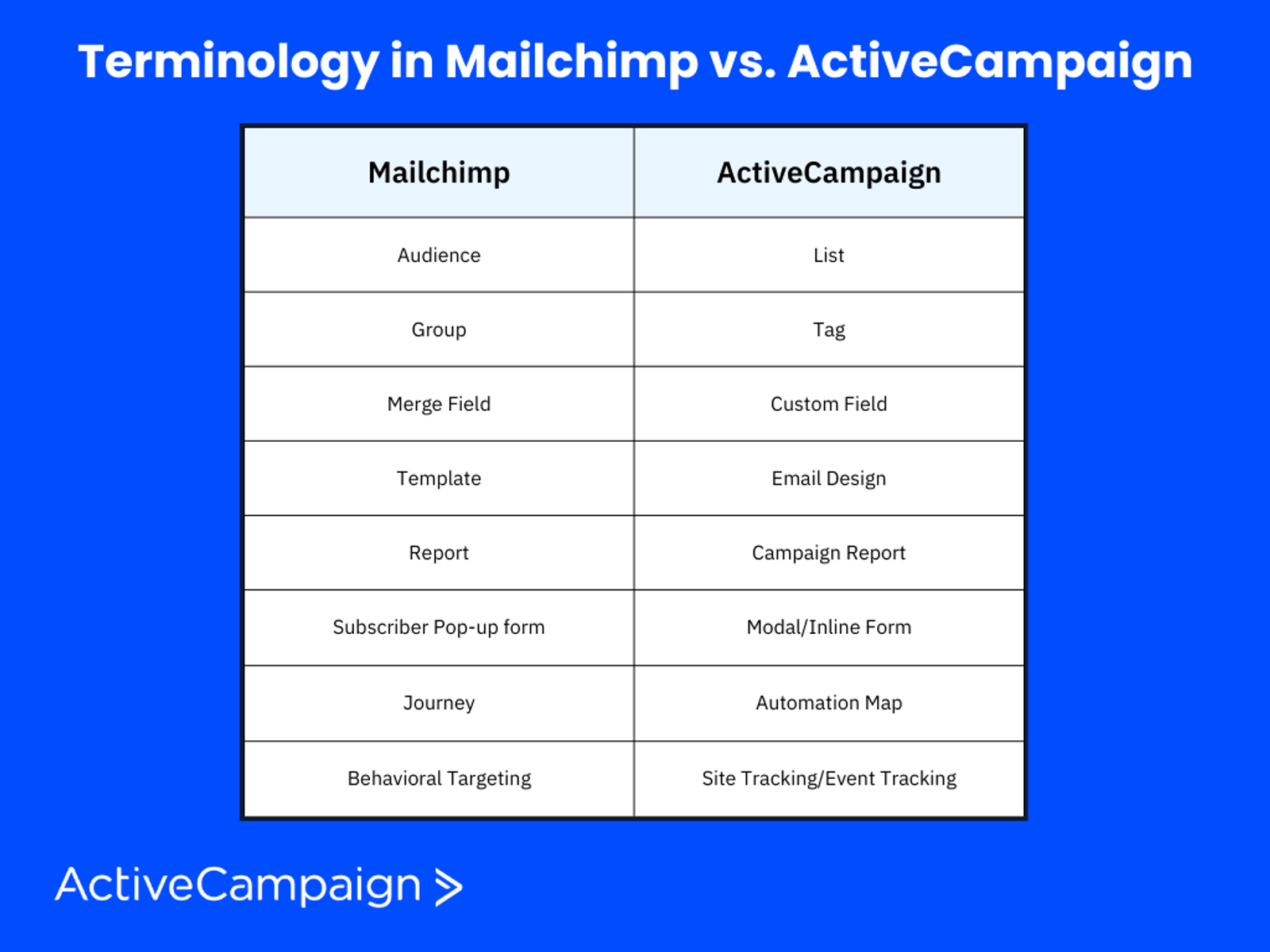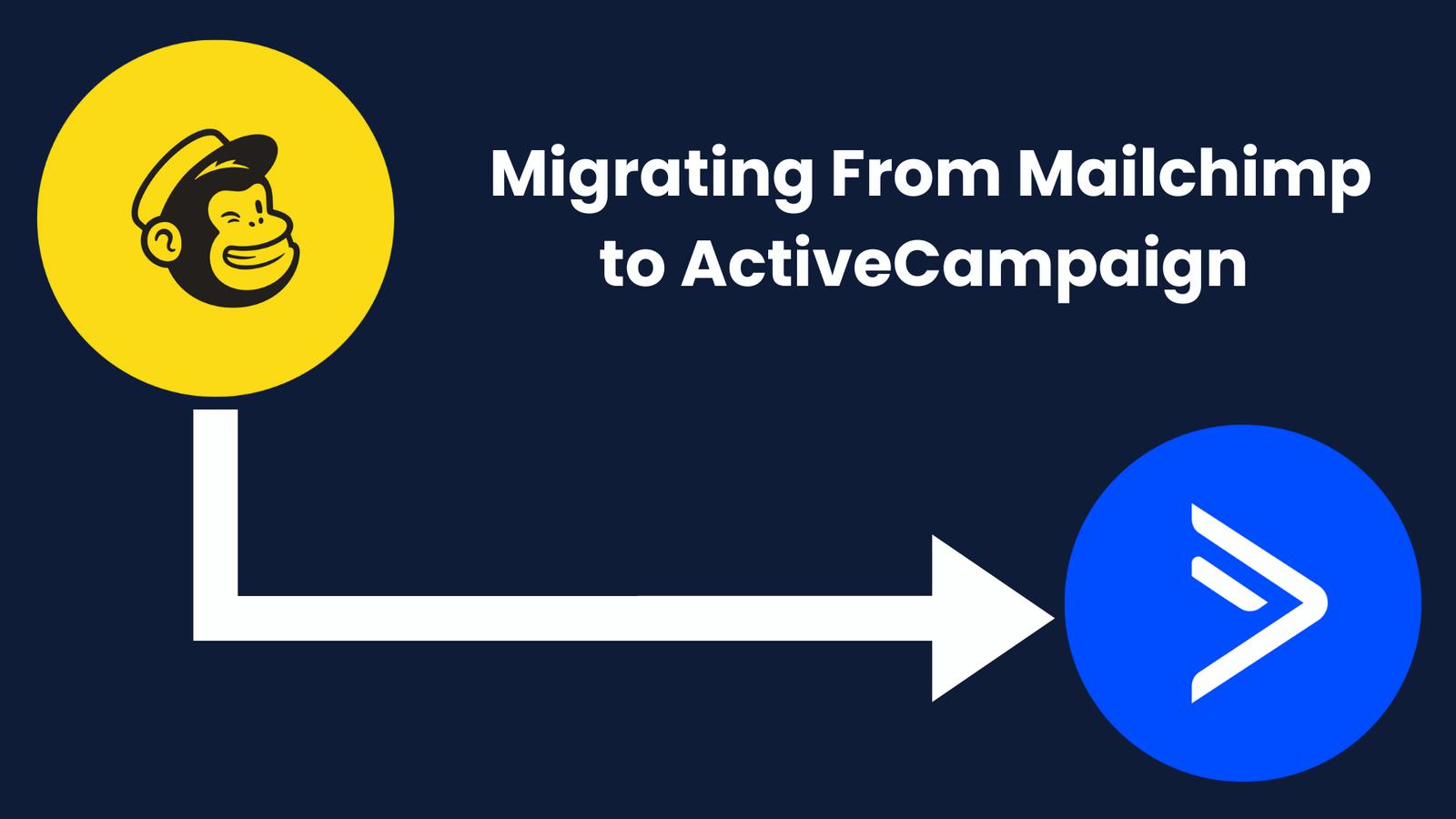Migrating from one email marketing platform to another is a significant decision for any business. It's not just about moving data; it's about ensuring continuity in your marketing strategies and maintaining the integrity of your customer relationships.
Transitioning from Mailchimp to ActiveCampaign, for instance, offers the opportunity to enhance your email marketing efforts with more advanced features and customization. However, this process requires careful planning to avoid data loss or disruptions in your communication flow.
If you're new to email marketing, understanding the basics is crucial before diving into migration. Email marketing is a powerful tool for businesses to communicate with customers and prospects. It involves sending emails to a list of contacts with the aim of promoting products or services, sharing news, or engaging your audience.
Effective email marketing is about delivering the right message to the right people at the right time, which can significantly impact your customer engagement and business growth.
Migrating from Mailchimp to ActiveCampaign
Considering a migration from Mailchimp to ActiveCampaign? This move can bring numerous benefits, such as enhanced automation capabilities, more robust segmentation, and advanced personalization features that can elevate your email marketing strategies.
For a detailed comparison and more reasons why ActiveCampaign might be a better fit, even if you're a current Mailchimp user, check out our comparison guide.
Migrating from Mailchimp to ActiveCampaign can uplevel your email marketing and give you access to capabilities like superior automation and advanced personalization. Before transitioning, it's essential to understand what the migration process entails and how to prepare for it.
Key steps include:
- Backing up all Mailchimp data, including contacts and campaign reports
- Exporting essential elements like contacts, tags, segments, and email templates
- Assessing your current Mailchimp setup to understand what needs to be migrated
- Planning for any strategic changes in marketing post-migration
- Getting familiar with ActiveCampaign's features and interface for a smoother transition
IMPORTANT: This guide isn’t meant to be read from top to bottom but instead used as a reference guide to help complete any steps you need help with. The best way to use this guide is by taking advantage of the “jump to a section” on desktop or scrolling until you find the topic you’re looking for on mobile.
ActiveCampaign's migration support
ActiveCampaign offers a comprehensive migration service to ease your transition from other email marketing platforms.
Our team assists in importing your lists and up to three items each from your templates, automations, and forms/landing pages. This support minimizes any potential data loss and helps you get up and running quickly on our platform.
Phase 1: Starting the process in your Mailchimp account
The very first thing you’ll need to do is export and save all of your data from Mailchimp so that it’s easy to import into ActiveCampaign in the next phase.
Step 1: Log into Mailchimp:
Start by logging into your Mailchimp account and navigate to the "Lists" section at the top of the page. This is where you’ll export your lists and segments.
Step 2: Exporting lists, segments, and tags
Next, you’ll want to export your lists and segments. In Mailchimp, a list is called an audience.
- For audience:
- Click on “Audience” and then “All contacts”
- Select the list you want to save under “Current audience”
- Find and click the “Export Audience” button
- Click “Export as CSV” to download your contacts
- Repeat for other audiences you have
It’s important to note that while segments can’t be directly imported into ActiveCampaign, it’s good to have them saved for reference and backup.
Step 3: Export reports and templates
While reports and templates can’t be imported to ActiveCampaign directly, you can export campaign data and HTML from your templates. This will give you access to the data you need (in reports) if you ever need to reference back to previous campaigns, as well as an easy way to add new templates (HTML) once in ActiveCampaign.
- For reports:
- Navigate to the Analytics tab within your Mailchimp account.
- Select the audience you wish to export your tags from at the top of the page
- Click the “Download All Reports” button to export data from all reports related to your audience.
- You can also download individual reports by clicking the dropdown button next to the report and clicking “download”
- Alternatively, you can also use the filters to export reports by status, type, or within self-created folders
Step 4: Forms, surveys, and automations
While there is no way to import forms and automations directly into ActiveCampaign from Mailchimp, it’s a good idea to save these for easy reference or make sure you still have access to your Mailchimp account when you go to recreate them in ActiveCampaign.
This is especially important for automations. Before migrating, document the flow, triggers, conditions, and actions of your Mailchimp automations. Understanding the logic and sequence of these automations is crucial for a successful migration.
Tips on ensuring data integrity during export
When exporting data from Mailchimp, maintaining the integrity of your data is crucial. To ensure that your valuable information remains accurate and intact throughout the process, follow these tips:
- Double-check exported files: After exporting your contacts, tags, segments, reports, and templates, take the time to review the exported files for completeness and accuracy. Check if all the required fields are present and if the data aligns with what you have in Mailchimp.
- Verify file formats: Ensure that the file formats of your exported data are compatible with ActiveCampaign. For instance, contact lists are often exported as CSV files, which are widely accepted for imports. If you've exported HTML templates, verify that the code is intact and has not been altered during the export process.
- Secure data storage: Keep your exported data secure. Consider using encrypted storage solutions while the data is in transit from Mailchimp to ActiveCampaign. The security of your customer data is crucial, particularly when handling personal and sensitive information.
- Backup before export: Before initiating the export process, it’s wise to create a backup of your entire Mailchimp account. This precaution ensures that you have a fallback option in case something goes wrong during the export process.
- Use checksums for large files: For larger data files, consider using checksums to verify the integrity of the data post-export. This technical step helps ensure that the file was not corrupted during the export process.
By following these steps, you can minimize the risks of data corruption or loss during the export process from Mailchimp. Ensuring the integrity of your data is critical for a smooth transition to a new email marketing platform.
Now that you've successfully exported all the essential data from Mailchimp, it’s time to begin phase 2 of your migration journey – setting up your ActiveCampaign account. This next phase is crucial in harnessing the full potential of your carefully curated data and beginning a new chapter in your email marketing strategy.
Phase 2: Setting up your ActiveCampaign account
In this section, we’ll cover everything from creating your ActiveCampaign account to importing your contacts and lists.
Step 1: Creating an ActiveCampaign account
Creating an ActiveCampaign account is a straightforward process that opens the door to a suite of advanced email marketing tools and features. To get started, visit the ActiveCampaign pricing page and choose the plan that best suits your business needs. ActiveCampaign offers a variety of plans to cater to different sizes and types of businesses, each with a unique set of features and capabilities.
If this is your first time using ActiveCampaign, we offer a 14-day free trial, or you can schedule a demo. You’ll be able to explore the platform's robust functionalities, such as automation, segmentation, and CRM integration, without any initial commitment. Setting up your account is as simple as providing some basic information about your business and email marketing needs.
Once your account is created, you can start importing your data from Mailchimp and begin experiencing the powerful benefits of ActiveCampaign's marketing automation and personalized email capabilities.
Step 2: Importing contacts and contact data
Importing your contacts and their data into ActiveCampaign from Mailchimp is a crucial step in the migration process.
Here's a detailed guide to ensure a smooth transition:
- Start the import process:
- Before importing, make sure your CSV files exported from Mailchimp are ready. This includes your contacts, tags, segments, and any other relevant data.
- Double-check the files for accuracy and completeness. Ensure that all essential data fields are included and correctly formatted.
- In your ActiveCampaign dashboard, navigate to the “Contacts” section and then click on “Lists.”
- Click on “Add a list” and create a new list. This list should correlate to the Mailchimp audience that you will be importing.
By following these steps, you can ensure that your valuable contact data from Mailchimp is successfully and accurately imported into ActiveCampaign, setting the stage for more personalized and effective email marketing campaigns.
Step 3: Recreating Mailchimp segments in ActiveCampaign
As mentioned above, there is no way to directly import segments from Mailchimp into ActiveCampaign, but recreating them isn’t that difficult.
Recreating segments in ActiveCampaign
When you’re ready to recreate your segments in ActiveCampaign, start by navigating to the "Lists" section where you have already imported your Mailchimp contacts. Choose the specific list you want to segment and click on "Create a Segment." ActiveCampaign’s segment builder is intuitive and allows you to recreate the conditions of your Mailchimp segments.
An advantageous feature of ActiveCampaign is its dynamic segment capability, which automatically updates the segment as contacts meet your specified criteria.
Handling static segments
For those who used static segments in Mailchimp—essentially a fixed list of contacts—you can effectively recreate these in ActiveCampaign using tags. Tagging in ActiveCampaign is a method for assigning specific identifiers to your contacts. As you import your contacts from Mailchimp, it’s a good practice to add a tag that corresponds to each of your static segments. This approach allows you to easily manage and identify these contacts within ActiveCampaign.
Using tags for dynamic segmentation
If your segmentation strategy in Mailchimp was dynamic, you’ll find ActiveCampaign’s conditions and filters ideal for replicating this behavior. ActiveCampaign enables you to segment contacts based on a variety of criteria, including actions, behaviors, and contact details. To maintain the effectiveness of your marketing efforts, it’s crucial to regularly update and refine your segments in ActiveCampaign, ensuring they align with your current marketing goals.
Testing and validation
After setting up your segments in ActiveCampaign, a critical step is to test and validate them. Compare the segmented contacts in ActiveCampaign with your original segments in Mailchimp to confirm their accuracy. If discrepancies are found, make the necessary adjustments to your segment criteria to ensure they are effectively aligned with your marketing strategies.
By following these steps, you can effectively transition your segmented contact lists from Mailchimp to ActiveCampaign, allowing you to maintain your targeted marketing efforts with minimal disruption. Remember, segmentation is key to delivering relevant and personalized content to your audience, enhancing engagement, and driving conversions.
Step 4: Recreating email templates in ActiveCampaign
Transitioning your email templates from Mailchimp to ActiveCampaign is a straightforward process, especially if you have already downloaded the HTML of your Mailchimp templates and stored them in a .txt or .gdoc file.
Here’s how you can recreate these templates in ActiveCampaign:
- Accessing ActiveCampaign’s email designer: First, log in to your ActiveCampaign account and select ‘Campaigns.’
- Create a new template: Click on Campaign Templates and then ‘Create a Template’ in the upper right side of the screen.
- Importing Mailchimp HTML: If you have the HTML from your Mailchimp template, select “Custom HTML” and you will be able to copy and paste the HTML text into the box. This step brings over the basic structure and design of your Mailchimp template into ActiveCampaign.
- Adjusting and customizing: After pasting the HTML code, you may need to make some adjustments. This is because certain HTML elements or styles may render differently in ActiveCampaign. Spend some time tweaking the design to ensure it looks as intended. You can use the design tools provided by ActiveCampaign to modify layouts, change colors, or update fonts to match your brand's style.
- Adding ActiveCampaign elements: One of the advantages of ActiveCampaign’s email designer is its rich set of elements and blocks that you can drag and drop into your email template. Consider enhancing your imported template with elements like buttons, social media links, or personalized content blocks that leverage ActiveCampaign’s tagging and segmentation capabilities.
- Testing your template: Before using your new template for campaigns, it’s crucial to test it. Send test emails to see how your email renders across different email clients and devices. Ensure that all links work correctly and that the layout appears as expected. ActiveCampaign provides tools to preview your email on various devices, which can be immensely helpful during this stage.
- Saving and using your template: Once you are satisfied with the design and functionality of your template, save it within ActiveCampaign. You can then use this template for future email campaigns, ensuring consistency in your email marketing efforts post-migration.
By following these steps, you can efficiently transfer and adapt your existing Mailchimp email templates to ActiveCampaign, maintaining the familiar look and feel of your communications while leveraging the enhanced capabilities of ActiveCampaign.
Phase 3: Advanced migration: Automation, forms, and surveys
Migrating unique elements such as surveys, forms, and automations from Mailchimp to ActiveCampaign requires a strategic approach, as they can’t be directly imported and often involve complex configurations and personalized content.
Forms (and surveys)
- Review your Mailchimp surveys and forms: Start by reviewing all the forms you have in Mailchimp. Note down their structure, questions, and types of responses they gather. Since there's no direct way to export and import the form structure, you’ll need to manually recreate them in ActiveCampaign.
- Recreate forms in ActiveCampaign: Click on “Website” and then “Create a new form” to access ActiveCampaign's form builder to replicate the Mailchimp form as closely as possible to maintain consistency for your audience.
- Multiple forms: Repeat for each form or survey you wish to recreate
- Advanced forms: ActiveCampaign integrates with many third-party form tools if your forms or surveys are more complex than our form builder offers.
- Test your form before going live: Once your forms are set up in ActiveCampaign, thoroughly test them to ensure they are capturing data accurately and the user experience is smooth.
Automations
- Recreate automations in ActiveCampaign: Use ActiveCampaign's robust automation features to rebuild your workflows. Refer to your original Mailchimp automations or documentation to recreate your automations quickly.
- Improve your automations: ActiveCampaign offers advanced automation options, so you might find new ways to enhance your original automations.
- Testing and optimization: After recreating your automations in ActiveCampaign, test them thoroughly to ensure they trigger and function as intended. Use this opportunity to optimize the workflows for better efficiency or personalization.
Migrating unique elements like surveys, forms, and automations from Mailchimp to ActiveCampaign involves a mix of manual recreation and strategic planning. Ensuring a smooth transition requires careful documentation, replication of existing setups, and thorough testing to maintain the integrity and effectiveness of your marketing campaigns.
Terminology in Mailchimp vs. ActiveCampaign
There are quite a few notable differences when it comes to terminology in Mailchimp when compared to ActiveCampaign. For example, in Mailchimp, you can add your audience to a “group,” which is the same as adding a “tag” in ActiveCampaign. Another example is audience vs. list. Mailchimp's "Audience" represents the complete database of contacts along with their associated data. In contrast, ActiveCampaign's "List" pertains to a specific segment of contacts within the broader database.

There are also a few terms that are common to both platforms, but have slight differences in their functionality or options available.
- Campaigns: In Mailchimp, "Campaigns" encompass a variety of marketing efforts, including email campaigns, ads, and social media posts. ActiveCampaign's use of "Campaigns" refers specifically to targeted email campaigns.
- Automation: While both Mailchimp and ActiveCampaign feature "Automation" for sending sequences of triggered emails, ActiveCampaign offers more intricate triggers and conditional logic for personalization.
Welcome to ActiveCampaign! What’s next?
The journey from Mailchimp to ActiveCampaign marks the beginning of a new chapter in your email marketing efforts. This process, while meticulous, opens the door to a world of advanced features, refined targeting, and elevated customer engagement. As we've outlined, the steps from exporting your vital data from Mailchimp to importing and revitalizing your campaigns in ActiveCampaign are structured to be seamless and secure.
We understand that transitioning platforms can seem daunting, but with ActiveCampaign's comprehensive guide and dedicated support, you're not alone. Now that you're equipped with the knowledge of the process, it's time to take the leap.
Start by setting up your ActiveCampaign account, where a 14-day free trial awaits to let you explore the interface and features without commitment. Or, if you're ready to jump in, contact our sales team and request a demo.
Start your migration today and unlock the full potential of your email marketing with ActiveCampaign. It's not just about making a change; it's about making a change for the better. And remember, our team is here to assist you at every step, ensuring that your move to ActiveCampaign is a resounding success. Welcome to the future of your email marketing journey.








